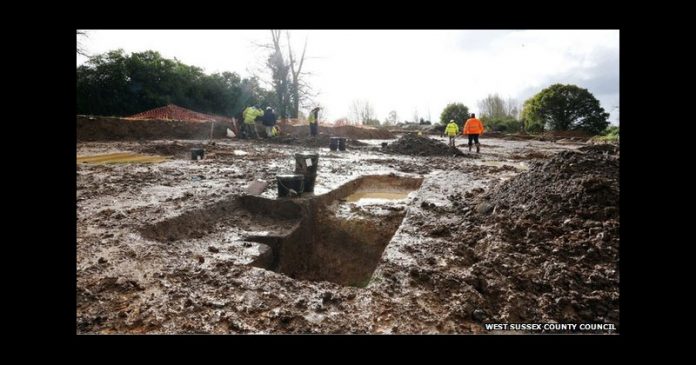An excavation in Barnham,West Sussex by Archaeology South-East unearthed a range of artefacts dating back to the Late Iron Age and early Roman occupation.
This exciting find further supports evidence of a Roman settlement in the village and includes what seems to be a 2000 year old ‘village pond’.
Archaeologists from West Sussex County Council, Archaeology South-East, and CgMs Consulting made the discovery at the former Angel’s and Hyde Nursery site, Barnham.
Over six weeks in October and November they uncovered Roman pottery, ancient rubbish pits and ditches.
The excavation work has been undertaken as a condition of planning permission granted to WSCC by Arun District Council for the County Council’s development of the land for housing.
John Mills, West Sussex County Council’s Senior Archaeologist, said: today: “As often happens on ‘Time Team’, there was a surprise on this last day of the investigation. All the archaeological features appear today as filled with pale grey silt, and it is usually easy to see that these must be silted-up ditches, pits and post-holes.
A large round grey “splodge” on the site was puzzling everyone, until digging on the last day showed it to be a shallow depression, which is now thought to be a silted up Roman pond. Most of the pits where the inhabitants were dumping midden surrounded the pond, but why was this? Samples of the soil filling the pits may show more about what the pits were used for, and may also help to understand also the reason for the pond’s being there.
Water management was evidently an important consideration in Roman times, just as it is today. Many of the Roman ditches, defining plots of ground within the site, are thought to have been drainage ditches. These had silted up quickly from rainwater and had to be dug out again at intervals. Sometimes the original ditches may have been dug out again, but in other cases, perhaps when the original ditch fill had become foul, new drainage ditches were dug out instead, right alongside the silted-up original ones.
Fragments of pottery show that the inhabitants of the settlement were obtaining their household pottery vessels from kilns in the Arun Valley, a thriving local industry, and from the Rowlands Castle and New Forest areas.
Among the finds have been a couple of flue tiles, of a type used in under floor heating in Roman stone buildings – possible evidence of a more important Roman building nearby.
Experts believe the settlement, which continued until after 200AD, may have started life even before the Roman Conquest of 43 AD in the Late Iron Age.



